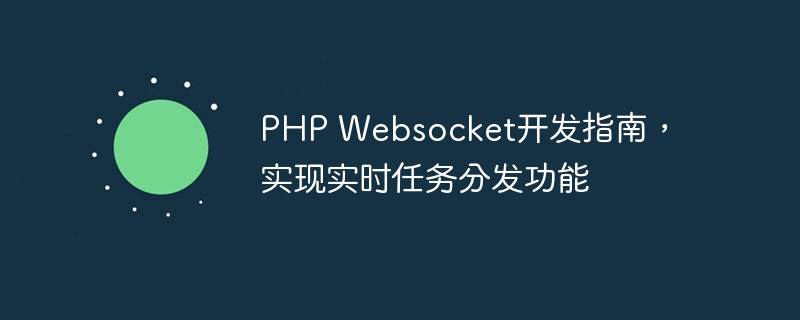

PHP Websocket Development Guide, to implement real-time task distribution function, requires specific code examples
Introduction:
In modern Web applications, real-time task distribution function has become becomes more and more important. Through real-time task distribution, real-time communication and real-time updates can be achieved, providing users with a better interactive experience. PHP Websocket is a technology used to achieve real-time communication. This article will introduce the basic principles and usage of PHP Websocket, and provide specific code examples to help readers understand and implement real-time task distribution functions.
Section 1: What is Websocket
Websocket is a full-duplex communication protocol. It is established on a TCP connection and realizes real-time two-way communication between the server and the client through the handshake process. Compared with the traditional HTTP protocol, Websocket has lower network latency and higher real-time performance.
Section 2: Principle of PHP Websocket
The working principle of PHP Websocket can be briefly described as the following steps:
Section 3: How to use PHP Websocket
PHP Websocket can be implemented through PHP libraries such as Ratchet or Swoole. The following uses Ratchet as an example.
Step 1: Install the Ratchet library
First, you need to use the Composer command to install the Ratchet library. Execute the following command in the command line:
composer require cboden/ratchet
Step 2: Create Websocket Server
Create a server.php file in the project folder and write the following code in the file:
use RatchetMessageComponentInterface;
use RatchetConnectionInterface;
require 'vendor/autoload.php';
class MyWebSocket implements MessageComponentInterface {
protected $clients;
public function __construct() {
$this->clients = new SplObjectStorage;
}
public function onOpen(ConnectionInterface $conn) {
$this->clients->attach($conn);
echo "New client connected: {$conn->resourceId}
";
}
public function onMessage(ConnectionInterface $from, $msg) {
// Task distribution logic
foreach ($this->clients as $client) {
$client->send($msg);
}
}
public function onClose(ConnectionInterface $conn) {
$this->clients->detach($conn);
echo "Client disconnected: {$conn->resourceId}
";
}
public function onError(ConnectionInterface $conn, Exception $e) {
echo "An error occured: {$e->getMessage()}
";
$conn->close();
}
}
$app = new RatchetApp('localhost', 8080);
$app->route('/', new MyWebSocket, ['*']);
$app->run();Step 3: Run the Websocket server
Execute the following command in the command line to start the Websocket server:
php server.php
Step 4: Create the Websocket client
In the project folder Create a client.html file and write the following code in the file:
<!DOCTYPE html>
<html>
<head>
<meta charset="UTF-8">
<title>Websocket Client</title>
</head>
<body>
<script type="text/javascript">
const socket = new WebSocket('ws://localhost:8080');
socket.onopen = function() {
console.log('Connected to server');
};
socket.onmessage = function(e) {
console.log('Received message:', e.data);
};
socket.onclose = function() {
console.log('Connection closed');
};
</script>
</body>
</html> Step 5: Test Websocket Communication
Open client.html## in a browser #, and open the developer tools, you can see the log of successful connection in the console. At this point, a Websocket connection is established between the server and the client, allowing real-time communication.
Through PHP Websocket, we can easily implement the real-time task distribution function. In the code of step 2, you can see that the
onMessage method defines the logic of task distribution. When the server receives the task data sent by the client, it traverses all connected clients and sends the task data to each client using the send method.
public function onMessage(ConnectionInterface $from, $msg) {
// Task distribution logic
foreach ($this->clients as $client) {
$client->send($msg);
}
}Through the above steps, we have learned the basic principles and usage of PHP Websocket, and introduced how to implement real-time task distribution function. By using PHP Websocket, we can easily achieve real-time communication and real-time updates, improving user interaction experience. I hope this article will help you understand and use PHP Websocket.
The above is the detailed content of PHP Websocket development guide to implement real-time task distribution function. For more information, please follow other related articles on the PHP Chinese website!